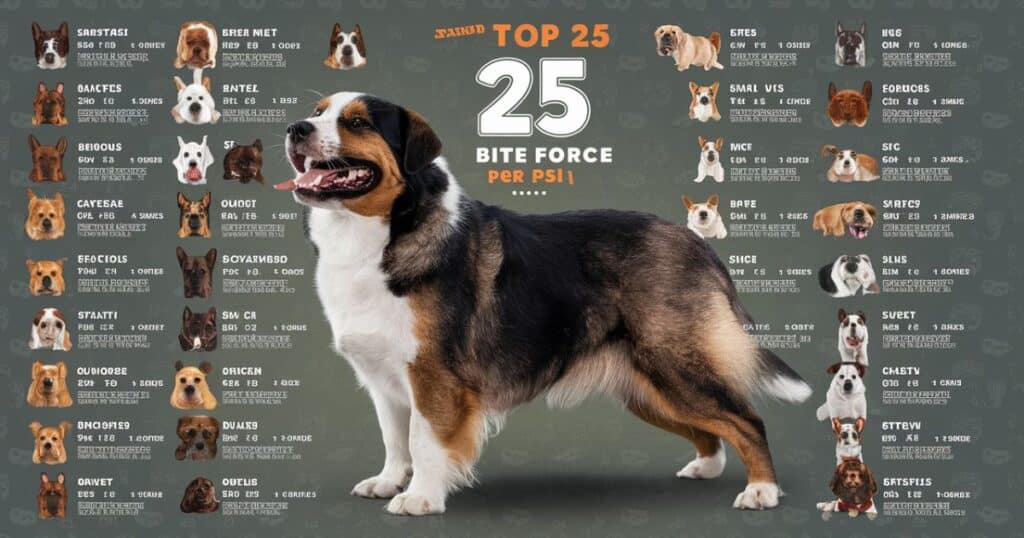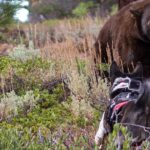Dogs come in all shapes and sizes, each with its own unique charm and abilities that never fail to amaze us. When it comes to raw power, few things in nature can match the bite force of certain dog breeds. Measured in pounds per square inch (PSI), this metric quantifies the sheer strength and intensity behind a canine’s chomp.
In this comprehensive guide, we’ll rank the top 25 dog breeds with the strongest bite force, exploring their backgrounds, traits, and the reasons behind their powerful jaws.
What’s PSI for a Dog Bite Force?
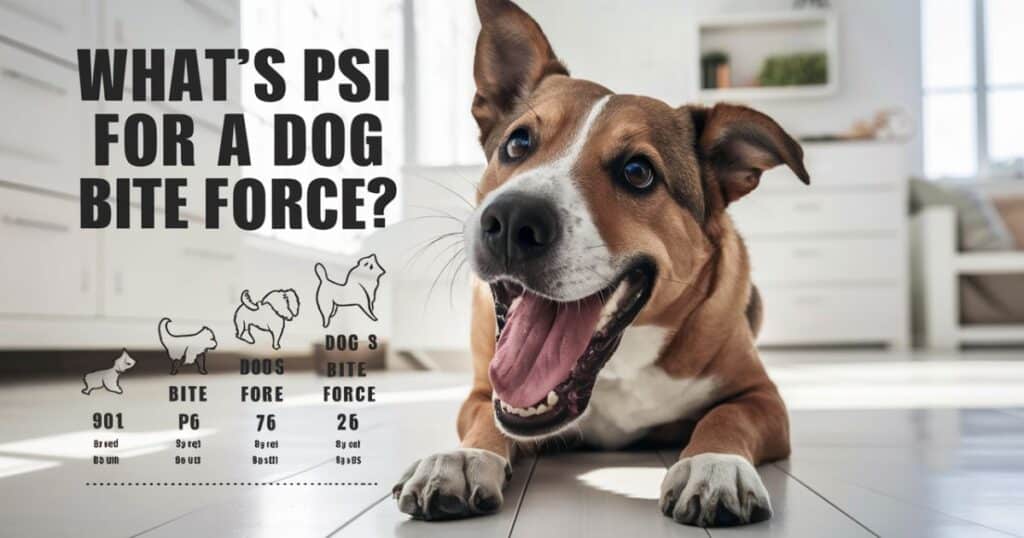
Bite force is typically measured in PSI (pounds per square inch), which calculates the amount of pressure exerted over a given area. For dogs, this translates to the immense force their jaws can generate when clamping down. A higher PSI indicates a stronger, more powerful bite.
While the exact PSI can vary between individual dogs, most domestic canines have a bite force ranging from 200-450 PSI. However, some breeds with strong bite force can exceed 700 PSI – easily enough to shatter bones or cause severe injury. Knowing a breed’s bite statistics is crucial for responsible ownership and public safety awareness.
Understanding Dog Bite Force
A dog’s bite force is influenced by several physiological factors, with breed being the primary determinant. Powerful dog breeds were often historically bred for jobs requiring a strong bite, such as:
- Guard dogs: Fending off intruders or attackers
- Hunting dogs: Taking down and restraining large prey
- Herding dogs: Controlling and moving livestock
- Baiting dogs: Latching onto and restraining larger animals
Beyond breed characteristics, other elements like jaw muscle mass, teeth shape/size, and head structure play a role. Larger dog breeds with robust skull/jaw anatomy tend to have more bite force capabilities.
It’s a common misconception that high bite force inherently means heightened aggression. While powerful breeds require experienced handling, a dog’s temperament is separate from its physical traits. With proper training and socialization, even strong-jawed dogs can make excellent companions.
ALSO READ: Top 15 Best Labrador Retriever Breeders In Maine (ME) For 2024
Dog Bite Force Ranking
This ranking of the top 25 dog breeds by bite force is based on documented testing data from multiple credible sources. However, it’s important to note that PSI figures can have some variance between individual dogs and measurement methods used.
Despite breed averages, a dog’s bite power can be impacted by factors like age, size, health, and training. This list provides a general reference point for the elite bite force capabilities found across numerous types of dogs.
Dog Breeds with Strong Bite Force with PSI ranking
Kangal – 743 PSI
Topping the bite force charts is the Kangal, a Turkish mastiff breed renowned as a formidable guard dog. Hailing from the Sivas province, these fawn-colored canines were employed for millennia by nomadic tribes to protect flocks from predators.
The Kangal’s colossal bite force of 743 PSI enabled it to fend off threats like wolves, bears, and even lions back in its homeland. Their loyalty, protective instincts, and sheer power made them indispensable assets during the Middle Ages and Holy Crusades.
Despite their size and strength, Kangals are praised for their calm demeanor and human devotion when properly trained and socialized from puppyhood.
Bandog – 730 PSI
A modern “designer” breed, the Bandog is a hybrid cross between an American Pit Bull Terrier and an English Mastiff. Originally engineered for maximum guarding abilities and “gameness,” this muscular beast clocks in with an average 730 PSI bite force.
While controversial for their intended aggression, responsible Bandog breeders have worked to tone down this tendency. Still, their powerful jaws hearken back to their ancestry – the “catch” dogs of Ancient Rome and the famed attack dogs favored by medieval Europeans.
Bandogs require an extremely firm, experienced owner who can properly control and socialize them from an early age. Their bite force potential demands the utmost responsibility.
Cane Corso – 700 PSI
The Cane Corso’s origin traces back to ancient Roman times, where this Italian breed was highly valued for its courage, loyalty and ability to be part of the familia. Their 700 PSI chomp enabled them to serve various roles from guard duties to assisting in battles and hunts.
Today’s Cane Corsos remain highly athletic and muscular, requiring an experienced owner who can manage their intensity and protective drive. Their imposing stance and furrowed brow only add to their intimidating presence.
While gentle with their humans, the breed’s bite force ranks among the most powerful – proof of their ancestral role as formidable warriors and guards.
Dogue de Bordeaux – 556 PSI
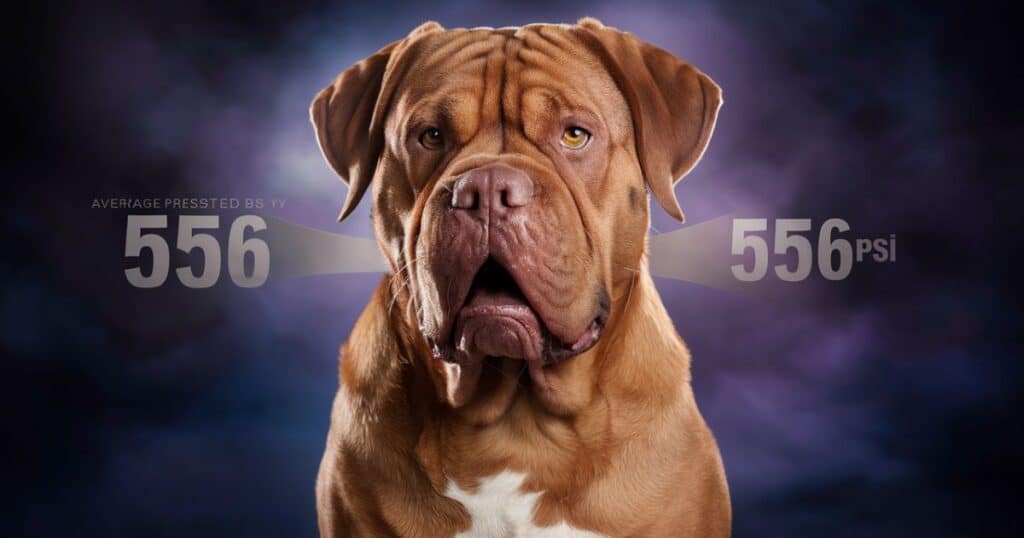
Descending from an ancient lineage of French mastiffs, the Dogue de Bordeaux (DDB) hails from the Aquitaine region in southwest France. By the 14th century, this brawny breed was employed by guards, hunters, and even featured in the sporting arenas against big game and other dogs.
The DDB’s broad muzzle and muscular build allow it to exert an average bite force of 556 PSI – strong enough to bring down prey like jaguars, wild boar and potentially even jaguars. While no longer used for gladiator-style entertainment, their power persists in their genetics to this day.
Their calm temperament, protective nature and relatively minimal grooming needs have helped make Dogues cherished modern companions despite their robust bite power.
Tosa Inu – 556 PSI
Named after the Japanese province it originated in, the Tosa Inu or Tosa Breed was cultivated in the 19th century as an elite fighting dog. Bred for maximum size, aggression and defensive abilities, it was forced into brutal combat against bears, bulls, and other dogs.
While no longer used for such dangerous scenarios, the Tosa’s appearance remains intimidating – standing over 2 feet tall and weighing up to 200 lbs, with a signature brindle coat and bulk muscle. Their 556 PSI bite force was meant to overpower and restrain much larger opponents.
Given their history as fighting dogs and intensity level, Tosas are prohibited in some regions and considered unsuitable as typical house pets. Immense power combined with a volatile temper requires the utmost responsibility from expert owners.
English Mastiff – 552 PSI
One of the most ancient breeds known, the English Mastiff’s lineage traces back to the days of ancient Britain and Roman militaries that employed them as ferocious attack dogs. Their size, strength and dominating 552 PSI bite enabled them to overtake human intruders with sheer force.
In the 1500s, the fearless Mastiff was even used for lion-baiting entertainment alongside bear-baiting breeds like Bulldogs. While this brutal practice has been outlawed, ethical Mastiff owners channel the breed’s intensity into legal sports like weight pulling competitions.
With their imposing stature yet gentle demeanor, well-trained modern Mastiffs exemplify a perfect balance of power and noble temperament when guided by a confident owner.
Dogo Canario – 540 PSI
The Dogo Canario traces its roots to the Presa Canario, a “catch dog” developed centuries ago on the Canary Islands to hunt large game like wild boar and immobilize escaped cattle. Their impressive bite force of 540 PSI gave them a clear advantage in bringing down formidable prey.
Standing up to 25 inches at the shoulder with a muscular yet athletic frame, the modern Dogo retains its ancestral physicality and intensity on the job. Always discerning but protective, they make superb guard dogs and are often employed in police, military and personal protection roles.
While remarkably strong-willed and confident, socialized Dogos can be affectionate family companions – as long as their significant training and exercise needs are met by experienced owners.
Dogo Argentino – 500 PSI
Developed in the 1920s by Antonio Nores Martinez of Cordoba, Argentina, the imposing white Dogo Argentino was selectively bred from the best Cordoban fighting dogs around. Their desired traits included an unstoppable work ethic, intense drive and of course – incredible bite strength.
Measuring up to 500 PSI of bite force, the Dogo was originally used to chase down threatening wild boars, pumas, and other predators that threatened its owner’s property and livestock. While adept hunters, their primary role was to immobilize the prey through vigorous shaking and clamping with their jaws.
Akita Inu – 400 PSI
Renowned for their courage, dignity and unwavering loyalty, the powerful Akita Inu was originally bred in Japan to guard royalty and nobility. Their 400 PSI bite force was honed for tackling large game like bear, deer and wild boar.
The breed’s strength and athleticism are evident in their thick double coat, muscular build and distinctive “samurai-like” facial markings and erect ears. Though reserved with strangers, a well-trained Akita develops incredibly strong bonds with its human family.
While not inherently aggressive, the Akita’s intensity requires an experienced owner who can be a strong yet fair leader. Underestimating their raw power and protective drive has led to attacks in the wrong hands.
Leonberger – 399 PSI
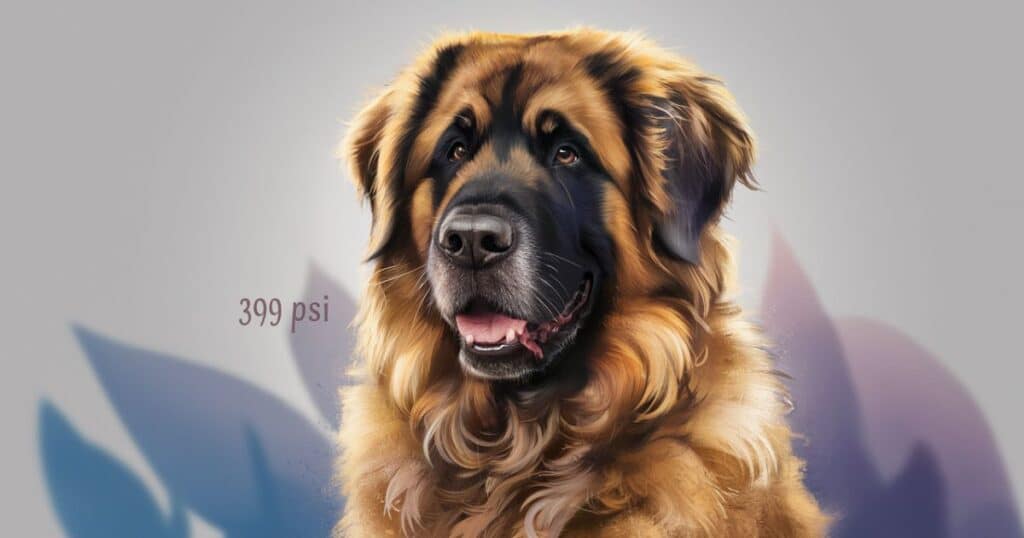
One of the biggest dogs around, the Leonberger combines strength, intelligence and a loving nature into an imposing yet elegant package. Their bites clock in at around 399 PSI of force, making them excellent guardians and companions.
Despite looking like a real-life lion, the Leonberger’s lineage is a mix of Newfoundland, St. Bernard and Great Pyrenees in the German town they’re named after. Originally bred as tough farm dogs and family protectors, their size and steady temperament suit the roles wonderfully.
While capable of being intense, proper socialization unleashes the Leonberger’s naturally gentle side with kids and owners they trust. Still, one must respect their huge bite power – especially when defending their loved ones.
Rottweiler – 328 PSI
Few breeds instill as much respect and caution as the muscular, blockhead Rottweiler. Initially herding dogs used to drive cattle and intimidate predators, their 328 PSI bite force remains a formidable weapon when employed as guard or police dogs today.
Rottweilers are known for their courageous, confident personalities and intense desire to work. This drive is what makes them naturals for roles like personal protection, search and rescue, and law enforcement – where obedience and controlled aggression are crucial.
While Rottweilers tend to be affectionate and loyal with their families, their size and strength demand an experienced owner that can establish firm leadership. Improper handling of such a powerful breed can prove disastrous.
Staffordshire Bull Terrier – 328 PSI
Despite their compact size, Staffies pack a serious punch with a bite registering 328 PSI – the same intensity as the larger Rottweiler breed. Originally bred for the controversial sports of bull and bear baiting, these muscular terriers retain the remarkably strong jaws they were prized for.
The good news is that today’s Staffies make for extremely devoted, loving family companions with proper socialization and training. Confident yet goofy, the breed bonds tightly to their humans and are uniquely gentle around children despite their fierce appearance.
However, complacency with a Staffordshire’s power is unwise. Their bite force ability combined with their tenacity means firm obedience is essential from day one. They require experienced owners who understand terrier intensity.
Siberian Husky – 320 PSI
Known for their striking looks, big personalities and impressive endurance, Siberian Huskies were bred to pull heavy sleds across frozen tundras. Their 320 PSI bite helped them fend off potential predatory threats while working.
While far from the strongest biters on this list, a Husky’s jaws are still nothing to underestimate. These energetic sled dogs descend from the Chukchi tribe’s robust spitz-types that assisted with hauling loads and hunting seals and polar bears when needed.
Even as modern family pets, responsible Husky owners must be prepared for their incredible exercise needs, prey drive and potential to accidentally injure others with those powerful jaws when excited.
American Bulldog – 305 PSI
The American Bulldog’s bite measures 305 PSI on average – slightly less than their English counterparts, but still incredibly powerful in the “bully breed” category. Developed in the 1800s for guarding, hunting and farm work, these catch dogs were tireless in their determination.
While calmer than their more overly aggressive ancestral lines used for bloody sports like bull-baiting, American Bulldogs remain fierce protectors of their homes and families when called for. Their stout frame, physical prowess and locking jaws made them ideal guardians and hunter’s helpers.
With the right experienced owners providing constant socialization and training, AmBullies can be affectionate if stubborn companions. Their intimidating bite force suits them best for controlled working roles versus typical household pets, however.
Bull Terrier – 269 PSI
Often described as the “kid in the dog playground,” the unique-looking Bull Terrier was originally bred to be a ferocious pit-fighter and badger batcher. Yet underneath their distinct egg-shaped heads lies a mischievous, clownish personality that delights families today.
Don’t let their silly side fool you, though – those awkwardly shaped jaws can snap together with over 269 PSI of biting power. While not the strongest on this list, it’s more than enough force to inflict serious damage if not properly controlled and socialized.
Most Bull Terriers make excellent companions when their energy, stubbornness and prey drive are consistently managed by owners prepared for a bull’s tenacity packed into a 50-60 lb missile of muscle.
ALSO READ: The Top 8 Labrador Retriever Puppies For Sale In Colorado: 2024 Breeders List
German Shepherd – 238 PSI
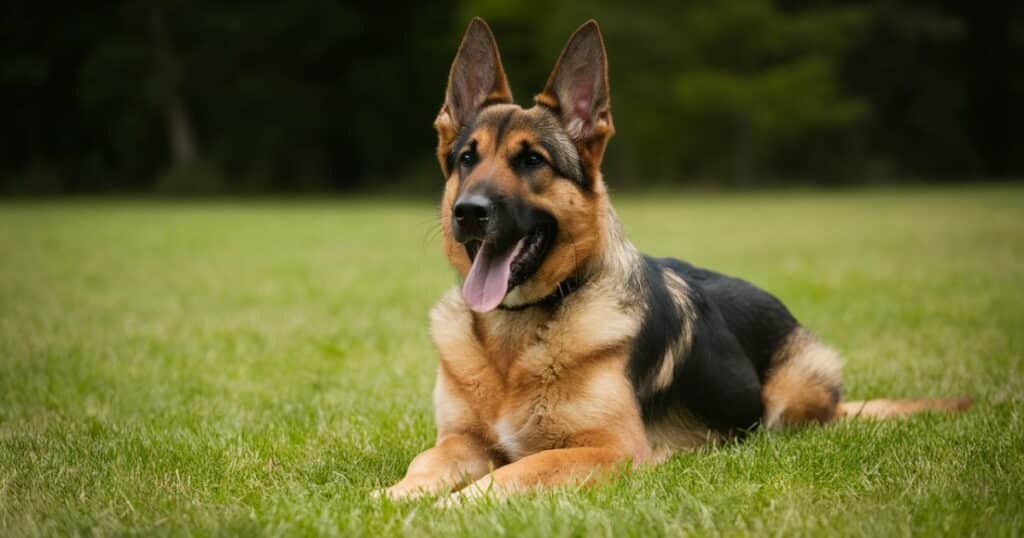
As one of the world’s most popular and versatile working breeds, the German Shepherd was purposely bred for active duty requiring strength, intelligence and a degree of controlled aggression. Utilized extensively worldwide, the GSD’s 238 PSI bite helped it excel in roles like police, military, herding and protection services.
German Shepherds are highly athletic and driven dogs, possessing outstanding loyalty to their owners yet often aloof toward strangers. This makes for an excellent property guardian when their territorial instincts are properly channeled through training and socialization.
While gentle with families, their size and strength means GSD ownership should never be taken lightly. Responsible owners must establish respected leadership over these confident herding dogs from an early age.
Great Dane – 238 PSI
Despite being recognized as one of the tallest dogs around, the gentle Great Dane can bite down with the same force as a German Shepherd at 238 PSI. “The Apollo of Dogs” grew in stature and strength generation after generation, first serving as valuable hunting companions for nobility across Europe.
Though their size is undeniably intimidating, modern Great Danes are far from aggressive beasts. On the contrary, these giants are affectionately called “gentle giants” and “couch potatoes” due to their surprisingly low exercise requirements and mild, people-oriented temperaments when properly trained.
However, the sheer size disparity means even those powerful jaws can cause major accidental injury if not educated from puppyhood on bite inhibition and control. Proper Dane ownership necessitates supervision and management of that bite potential.
American Pit Bull Terrier – 235 PSI
Arguably the most controversial and misunderstood breed around, the American Pit Bull Terrier combines staggering power and athleticism with an eagerness to please its owners. This dichotomy results in a 235 PSI bite force that, when channeled responsibly, makes them exceptional service animals and companions.
Originally designed for bull and bear-baiting sports that tested their gameness and ability to “pit” against larger animals, the APBT retains its drive and physical prowess. Yet when properly trained with firm boundaries, Pit Bulls demonstrate remarkable affection, loyalty and stability.
Their athletic abilities also lend well to weight pulling, protection, and obedience competitions where focused determination meets bite strength head on in legal environments. Given fair treatment, the APBT’s intensity shines as a working partner versus unharnessed menace.
Boxer – 230 PSI
Despite its goofy appearance and clownish personality around homes, the Boxer is all muscle and determination – packing a bite force of 230 PSI into their sturdy jaws and fawn-colored frame. Originally bred from the now extinct Bullenbeisser lines of Mastiff-type dogs, the modern Boxer descends from canines purchased by German and Dutch traders hundreds of years ago.
Their strength was highly useful back then for bringing down large game like bear, wild boar and deer on hunts across Europe. Today’s Boxer usually focuses their intensity into protection roles for families, police work or competing in schutzhund sports that challenge their guarding instincts.
Labrador Retriever – 230 PSI
As the most popular dog breed in the United States and much of the Western world, the friendly, versatile Labrador Retriever may seem like an unlikely candidate for a powerful bite. Yet Lab owners and experts know this breed’s “soft mouth” retrieval abilities don’t tell the whole story.
With a measured bite force of 230 PSI on average, a Labrador’s jaws are more than capable of inflicting serious harm if improperly trained. Their jaws were originally strengthened through retrieving tough waterfowl during hunting trips – a key part of their breed’s original duty.
While usually dedicated family companions today, the Labrador’s bite potential means committed obedience training and socialization from puppyhood onward is vital for such strong yet sweet dogs. Their biddability makes this process very manageable under responsible ownership.
Doberman Pinscher – 228 PSI
Sleek, muscular and exuding an aura of fearless confidence, the Doberman Pinscher has long been revered as an elite protection breed with a bite force of 228 PSI. Developed in Germany during the late 19th century, Dobies were originally intended to be tax collector guard dogs by their breed’s founder.
Over the decades, their roles expanded dramatically into governing forces like the military, police and personal protection details due to their strength, tracking skills and amenability to training. The AKC describes the ideal Doberman as possessing “compactness of form, dignity, and ease of movement.”
While tough as nails on duty, well-bred Dobermans are extensively socialized to be stable, discerning companions for families able to provide the exercise and mental stimulation they need. Still, their bite credentials remain highly respected in the working world.
Alano Español – 227 PSI
Hailing from Spain, the Alano Español (Spanish Bulldog) is a incredibly strong, muscular molossus breed whose lineage traces back over thousands of years. With a bite force of 227 PSI, these powerful dogs were bred to be fierce guardians of homes and livestock – taking on wolves, bears and any would-be intruder.
Their athletic build reflects their various working roles ranging from bull-baiting to boar hunting in the Spanish countryside over the centuries. Handlers had to be experienced, as Alanos were bred to relentlessly pursue their quarry until captured.
Today’s Alano fanciers describe the breed’s temperament as fearless yet obedient and calm when trained properly from an early age. Under the guidance of capable owners, their jaws become an asset versus a liability around families.
Rhodesian Ridgeback – 224 PSI
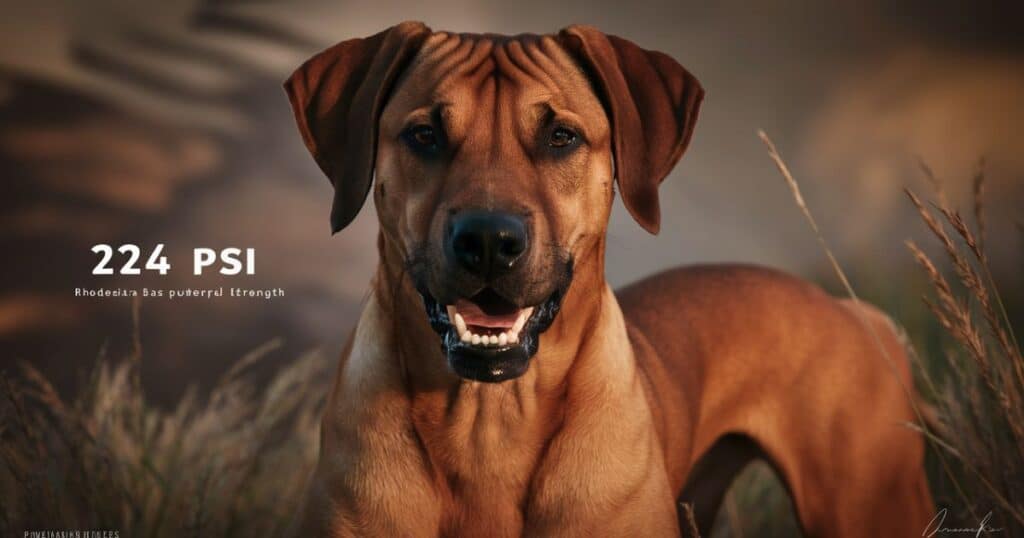
Distinguished by the distinctive ridge of backward-growing hair along their spines, Rhodesian Ridgebacks were originally bred in southern Africa to hunt large prey like lions while also serving as capable guardians of homes and families. Their versatility and athleticism is combined with a 224 PSI bite to fulfill these demanding roles.
As a larger sighthound-type breed, Ridgebacks have a “fair” amount of inbred protective aggression along with the speed and endurance to chase quarry. Their imposing houndy build hints at the origins of using these “lion hunters” to protect colonial homesteads from all manner of wildlife threats in Rhodesia.
While gentle when introduced properly, Ridgebacks remain very territorial guard dogs whose impressive size and bite abilities demand experienced, unwavering leadership from owners. Their desire to protect borders on being too much dog for casual households.
Dutch Shepherd – 224 PSI
Originally herding dogs bred in the Netherlands for their intense drive and focus, Dutch Shepherds have found exceptional success in recent years as elite police and military working dogs. That same 224 PSI bite force that helped them control livestock now assists in apprehending suspects and making them indispensable on patrol.
Similar in appearance to their Belgian Malinois cousins, the brindle and tan-coated Dutchies were highly valued for their bravery and protectiveness on farms in their homeland. Those traits translated well into the high-stakes world of law enforcement and personal protection.
Unlike most guarding breeds, the Dutch Shepherd remains relatively compact while combining that gritty working mindset and body built for constant activity. Their bites pack power into a highly energetic, intelligent package.
Chow Chow – 220 PSI
The lion’s mane ruff around the Chow Chow’s head gives it the undeniable look of a powerful apex predator – and their 220 PSI bite is certainly capable of backing that up. One of the few ancient dog breeds traceable to the lands of Mongolia and Northern China, Chows have held court as hunters, herders and guardians for thousands of years.
These muscular, sturdy dogs were developed with guarding and hunting traits that bred immense courage, independence and suspicion of strangers into their lineage. Their strength was amplified not just in their renowned bites, but in hauling heavy weights across tundras and facing off against bears.
While typically serene and regal around their families, poorly bred Chows can exhibit the same aggressive behavior that made them so effective at their jobs long ago. Their intensity requires owners with Chow experience from reputable breeders.
Conclusion
While a breed’s bite force stats make for interesting data comparisons, this metric alone doesn’t tell the full story of a dog’s behavior and personality. Powerful dog breeds like those highlighted require experienced owners committed to proper training, socialization and responsible handling from an early age.
At the same time, even smaller companion breeds harbor stronger bites than one might assume. All dogs require respect for their physical capabilities and familiarization with how to remain safe around them.
Ultimately, an owner’s dedication to raising a stable, obedience-trained dog plays the biggest role in channeling that bite force in safe, productive ways versus risky situations. By prioritizing responsible breeding and stewardship, we can appreciate a dog’s power while preventing potential incidents.
What did you think of this comprehensive look at the top 25 breeds ranked by their bite forces? I’m happy to provide any additional details or address any other questions about this topic. Let me know in the comments below!
ALSO READ THIS POST: 38 Amazing Labrador Retriever Mixes You Need To Know About

Davin Connor is an experienced author with 3 years in pets writing. Known for concise, informative content, he shares expertise on pet care, behavior, and health through his engaging articles.
